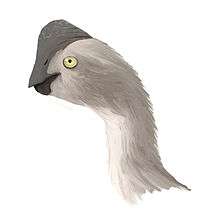Corythoraptor
| Corythoraptor | |
|---|---|
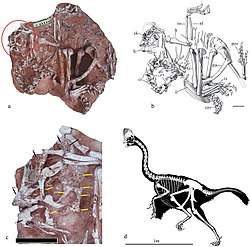 | |
| Holotype fossil and skeletal reconstruction | |
| Scientific classification | |
| Kingdom: | Animalia |
| Phylum: | Chordata |
| Clade: | Dinosauria |
| Order: | Saurischia |
| Suborder: | Theropoda |
| Family: | †Oviraptoridae |
| Genus: | †Corythoraptor Lü et al., 2017 |
| Type species | |
| Corythoraptor jacobsi Lü et al., 2017 | |
Corythoraptor (meaning "crested raptor") is a genus of crested oviraptorid theropod dinosaur from the Nanxiong Formation of China. It is known from one species, C. jacobsi, named after palaeontologist Louis L. Jacobs. Including it, there are seven oviraptorids known from the Nanxiong Formation, showing a high level of diversity in the area, and that the different taxa may have occupied different ecological niches.[1]
Description

Corythoraptor was a medium-size oviraptorid (about 1.6 meters long), reaching full size at more than eight years of age. Like its relatives, it would have been feathered, with small wings and a toothless beak. It had a characteristic crest different than that of any of oviraptorid which has compared to that of an cassowary. This crest and other features of the skull differentiate it from its closest relative, Huanansaurus.[1]
Discovery
The holotype, or type specimen, is a nearly complete skeleton of an individual at least seven or eight years old, lacking distal caudal vertebrae, comprising the skull and lower jaw (JPM-2015-001). It is one of better preserved oviraptorosaurian specimens known so far. It was discovered in the Ganzhou area of Jianxi province in southern China, near a railway station.[1]
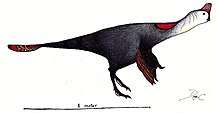
Phylogeny
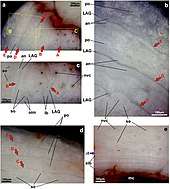
Phylogenetic analysis recovers Corythoraptor as member of the family Oviraptoridae, forming a clade with Huanansaurus as its closest relative, and Citipati, an unnamed taxon, Rinchenia and Oviraptor as the other closest relatives of that clade by declining degrees in the mentioned order.[1]
Below is a cladogram of Oviraptoridae based on the phylogenetic analysis of Lü et al. (2017).[1]
| Oviraptoridae |
| |||||||||||||||||||||||||||||||||||||||||||||||||||||||||||||||||||||||||||||||||||||||||||||||||||||||||||||||||||||
Paleobiology
Function of crest
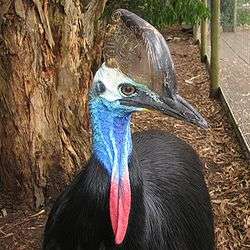
Suggestions as to the function of the crest has been made through comparisons with those of cassowaries and other oviraptorids; multiple potential functions have been identified, and it likely had more than one purpose. Modern cassowary casques serve in-part a thermoregulatory function, and the similarly structured crest of Corythoraptor could have likely had a similar effect.[1][2] Another possible use would be to detect and produce low frequency sounds for detection of predators or communication with other individuals. However, the authors cautioned this was likely not the primary purpose of the structure, and that the idea is complicated by the fact that it is unknown if both sexes had the crest. Instead, they suggest the crest was primarily a visual display structure. Both of these hypothesized functions would have served a sociosexual role.[1]
See also
References
- 1 2 3 4 5 6 7 Lü, J.; Li, G; Kundrát, M.; Lee, Y.; Zhenyuan, S.; Yoshitsugu, K.; Caizhi, S.; Fangfang, T.; Hanfeng, L (2017). "High diversity of the Ganzhou Oviraptorid Fauna increased by a new "cassowary-like" crested species". Scientific Reports. 7. doi:10.1038/s41598-017-05016-6.
- ↑ Phillips, P. K. & Sanborn, A. F. An infrared, thermographic study of surface temperature in three ratites: ostrich, emu and Double-wattled cassowary. Journal of Thermal Biology 19, 423–430 (1994).
